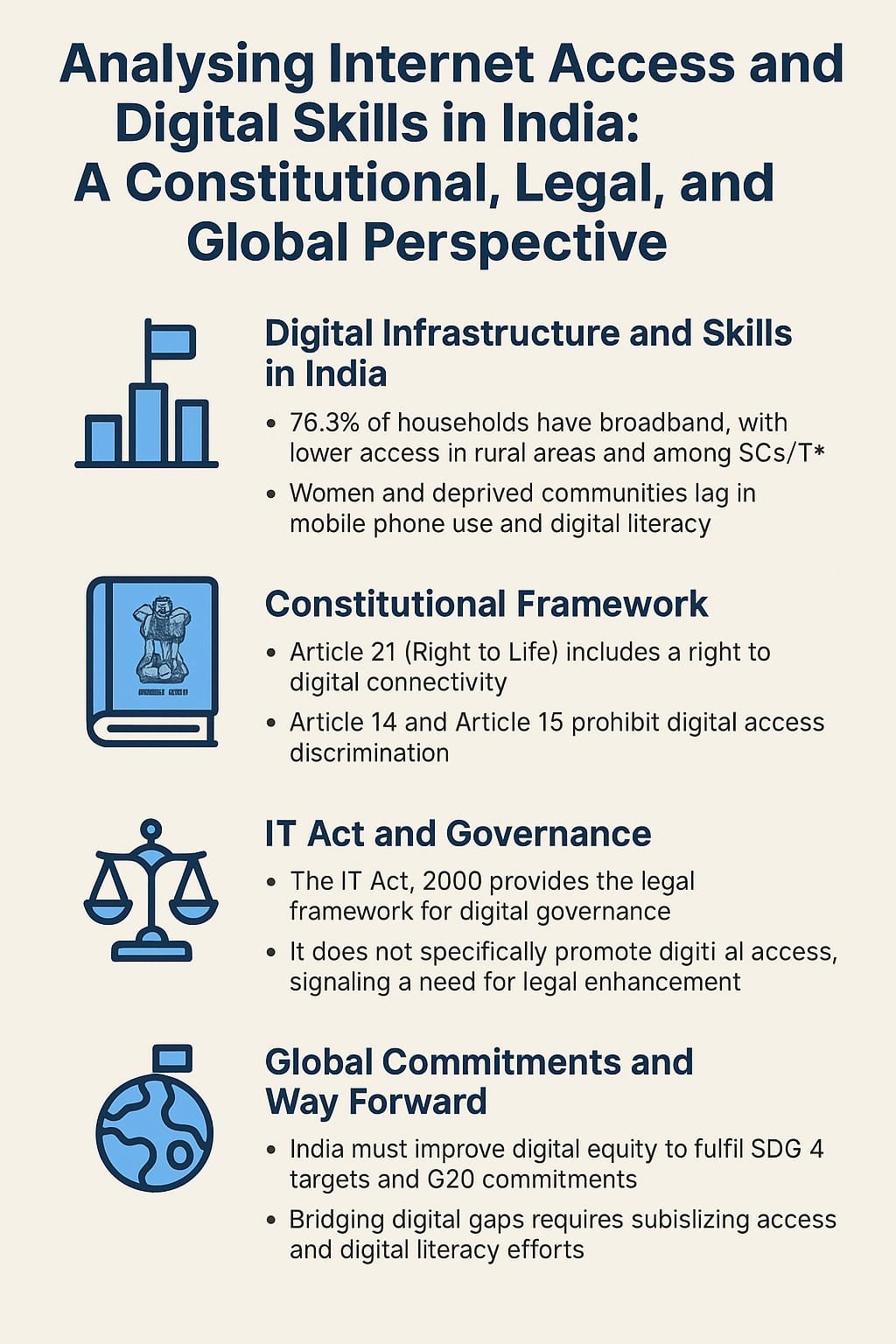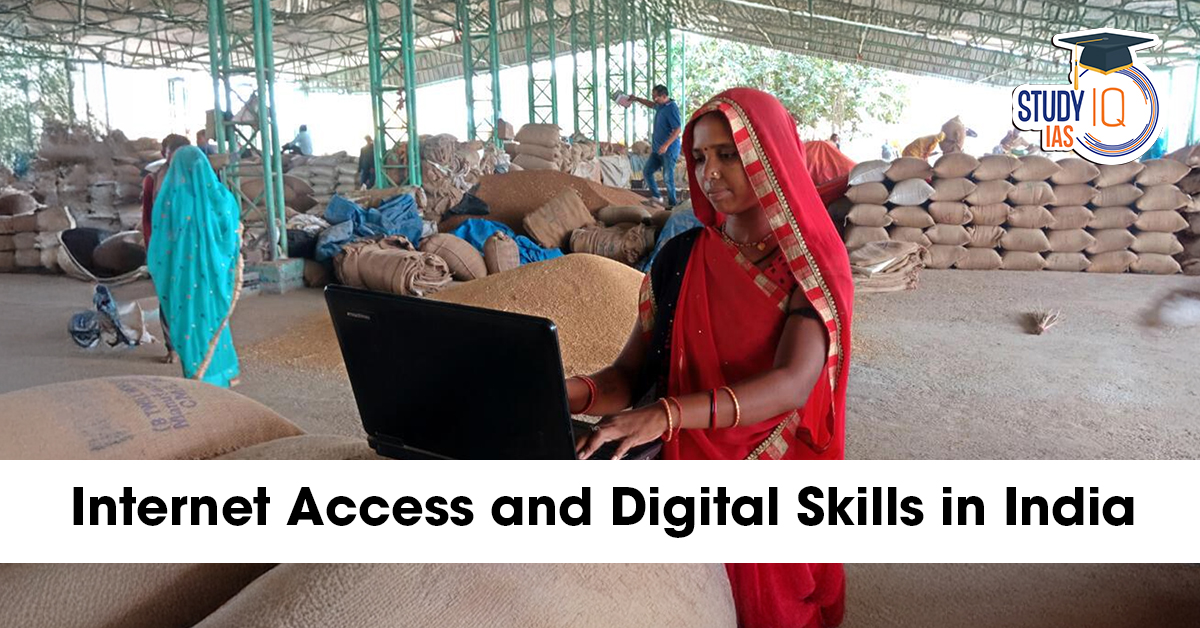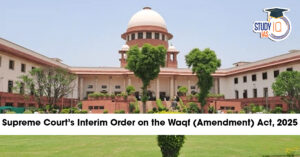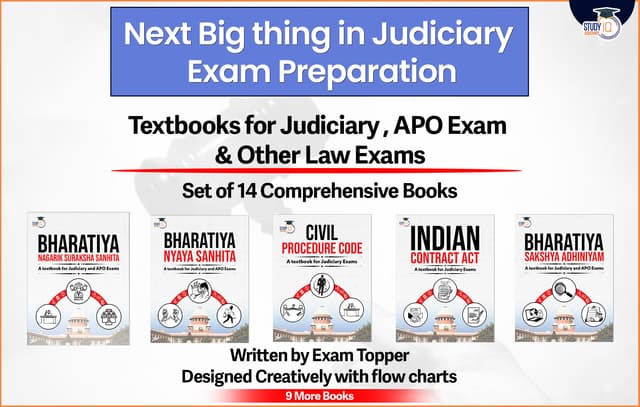Table of Contents
Access to digital infrastructure and attaining digital skills are not merely technology concerns but are fundamental to equitable development in the 21st century. By the United Nations Sustainable Development Goals (SDGs), particularly SDG 4 (Quality Education), India has initiated measures to assess and enhance the populace’s access to Information and Communications Technology (ICT).
The recent Comprehensive Annual Modular Survey (CAMS) conducted by the National Sample Survey Office (NSSO) from July 2022 to June 2023 provides a detailed analysis of digital access and skill distribution in India, highlighting significant socio-economic and geographical discrepancies.
Digital Infrastructure in India: Trends and Gaps
- The CAMS data indicates that 3% of Indian households own broadband Internet connectivity, with rural regions trailing urban areas (71.2% compared to 86.5%).
- States such as Delhi, Goa, and Manipur have internet penetration over 90%, but states like Arunachal Pradesh and Odisha demonstrate considerable deficiencies.
- Disparities are also seen across caste and income divisions:
-
- Households in the general category report an 84.1% broadband access rate, whereas OBCs have 77.5%, SCs 69.1%, and STs 64.8%.
- Economically, 71.6% of homes in the lowest income decile are without broadband, in contrast to merely 1.9% in the wealthiest decile.
- These figures highlight the ongoing digital gap, perpetuating existing class and caste inequities in access to knowledge and opportunity.
Mobile Phone Usage: A Gender and Social Divide
- India has remarkable mobile phone ownership statistics: 94.2% of rural households and 97.1% of urban households possess at least one mobile device.
- However, access and utilisation remain markedly unequal, particularly for women and underprivileged groups:
-
- Only 25.3% of rural women in the general category and an even smaller percentage among SC/ST women utilise mobile phones exclusively.
- Approximately fifty per cent of the rural population has access to 4G technology, but the utilisation of 5G is minimal.
- These disparities illustrate extensive socio-cultural and economic constraints, wherein patriarchal norms, inadequate educational achievement, and financial accessibility persist as obstacles to digital empowerment.
Assessment of Digital Skills: A National Shortfall
- The CAMS survey additionally evaluates actual digital literacy: 53.6% of rural Indians and 74% of urban Indians aged 15 and above are proficient in Internet usage.
- Fewer individuals are capable of executing fundamental digital tasks:
-
- Merely 20% of individuals in rural regions and 40% in urban areas possess the capability to send emails.
- Fewer than 40% of Indians possess the ability to copy and paste text.
- Merely 37.8% are capable of doing online banking transactions.
- These statistics pose a significant challenge to the Digital India initiative, suggesting that mere access does not ensure effective participation in the digital economy.
Constitutional Framework and the Right to Digital Access
- The digital gap is not merely a developmental concern; it overlaps with fundamental rights.
- Article 21 (Right to Life and Personal Liberty) has been judicially construed to encompass the right to education, access to information, and more recently, digital connectivity, particularly following the Right to Privacy ruling (Puttaswamy v. Union of India, 2017).
- Article 14 (Right to Equality) and Article 15 prohibit discrimination and require affirmative measures to address structural disparities, including digital inequalities.
- Article 39(f) of the Directive Principles mandates that the State must provide children and youth with chances and facilities for healthy development, which increasingly depend on access to digital technologies.

Anuradha Bhasin v. Union of India (2020)
- The case originated from the communication restrictions enforced in Jammu & Kashmir subsequent to the abrogation of Article 370 in August 2019. Anuradha Bhasin, a journalist, contested the comprehensive suspension of internet access, asserting it infringed against her fundamental rights under:
-
- Article 19(1)(a): Right to freedom of speech and expression
- Article 19(1)(g): Right to engage in any profession or pursue any occupation, trade, or business
- Article 21: Right to life and personal liberty
Ruling of the Supreme Court
- The Court determined that access to the internet is safeguarded under Article 19(1)(a) and 19(1)(g) as it serves as a medium for expression and commerce.
- The Doctrine of Proportionality mandates that any limitation on internet access must satisfy the criteria of need, proportionality, legality, and be open to judicial review.
- The suspension of services must be openly announced and is subject to regular assessment.
- The Supreme Court’s acknowledgement of internet access as a fundamental right under Article 19(1)(a) establishes a constitutional basis for initiatives promoting digital inclusion.
- The CAMS data indicates that significant portions of rural India, particularly the socio-economically disadvantaged groups (SCs/STs/OBCs) and women, persistently encounter structural obstacles in digital access and skill development.
- The CAMS data highlights differences related to area, income, caste, and gender. Disparities in access to the internet and digital skills, essential for education, work, banking, and communication, infringe against the right to equality (Article 14).
The IT Act, 2000 and Legal Backbone of Digital Governance
- The Information Technology Act, 2000, amended in 2008, serves as India’s principal legislation governing digital infrastructure and cyber regulation. It offers:
- Legal recognition of electronic governance (Section 6).
- Regulations concerning cybercrimes, data protection, and digital authentication.
- Section 66 criminalises hacking and identity theft, whereas Section 43A establishes data protection requirements for corporate entities.
- Nonetheless, although the Act pertains to cybersecurity and e-governance, it does not focus on enhancing digital access or education, underscoring the necessity for digital rights legislation that corresponds with advancing constitutional jurisprudence.
- Section 69A permits the government to restrict public access to material; nevertheless, Anuradha Bhasin stipulates that this authority must comply with constitutional protections.
- The Act does not specifically recognise digital access as a right; however, the Supreme Court ruling addresses this deficiency by subjecting IT legislation to constitutional scrutiny.
India’s Global Commitments: SDGs and Beyond
- India is a signatory to the UN Agenda 2030, and SDG Target 4.4 explicitly mandates:
- Increasing the number of youth and adults possessing necessary skills, including technical and vocational competencies, for employment and entrepreneurship.
- Targets 4.4.1 and 4.4.2 emphasise the cultivation and assessment of digital competencies as metrics of educational equity.
- India has advocated for digital public infrastructure (DPI) as a global public good through the G20 Digital Economy Working Group.
- Nonetheless, CAMS data highlights the domestic disparities India must address before it can function as an international model.
Policy Recommendations and the Way Forward
- Provide financial assistance for broadband connection to lower-income deciles to mitigate digital exclusion.
- Incorporate digital literacy into educational curricula for both schools and adult education, particularly in rural and SC/ST-majority regions.
- Implement gender-responsive ICT initiatives to close the gender digital divide.
- Revise the IT Act or enact new legislation that recognises digital access as a legal right.
- Utilise CAMS data to guide the implementation of Digital India 2.0, emphasising not only infrastructure but also fair digital engagement.
- Digital infrastructure and literacy are essential for the fulfilment of economic, social, and constitutional rights in contemporary India.
- The CAMS data indicates a promising increase in connection while simultaneously highlighting persistent inequities.
- Addressing these disparities is not merely a technological or economic necessity but also a constitutional and international obligation.
- The success of India’s digital future depends on guaranteeing that no citizen is excluded from the path to digital empowerment.


 Reserved vs General Quota: Supreme Court...
Reserved vs General Quota: Supreme Court...
 Supreme Court’s Interim Order on the W...
Supreme Court’s Interim Order on the W...



















